For every XF midsize luxury sedan Jaguar sold last year, Audi sold more than five of its A6 and A7, BMW sold more than seven of its 5-Series, and Mercedes sold more than eight of its E-Class. Jaguar is far from happy about this. In a bid to shrink those multiples, they've completely redesigned the XF for 2016. Are the reasons to buy one instead of an Audi, BMW, or Mercedes now considerably more compelling?
Note: while I most recently reviewed the BMW 5 Series in 535d form, I've driven the 535i a number of times, and the relative ratings are against the gasoline-powered sedan, not the diesel. This makes the biggest difference in the fuel economy area.
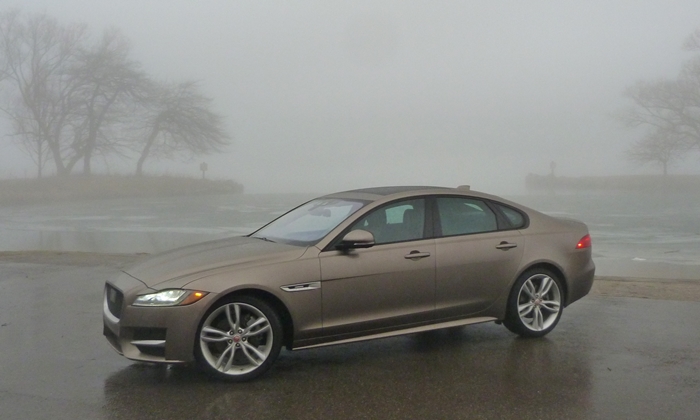
Sleek styling, without compromising passenger or trunk space. A difficult combination to pull off. more XF photos
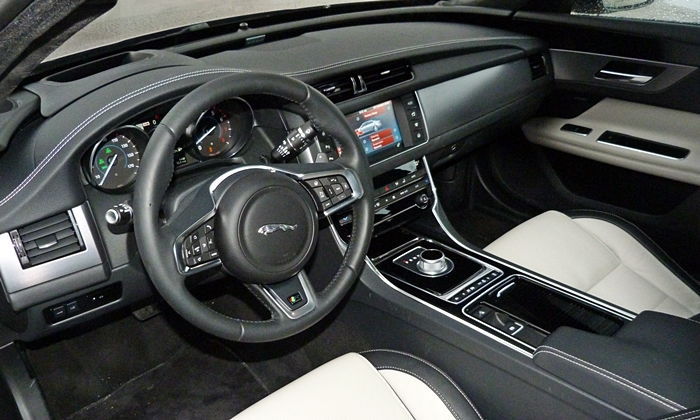
Certainly not a bad interior. But especially in a Jaguar I'd prefer styling less modern and severe.
| |
Compared to the 5-Series |
| Brand reputation & image |
 Better
Worse
Better
Worse
|
Unlike, say, Hyundai, Jaguar isn't new to top-shelf luxury sedans. Founded by Sir William Lyons, they've been building desirable high-end automobiles since before the second world war, and in the quarter-century after the war created some strikingly beautiful, cleverly engineered sports cars and sedans. The "leaper" badge might yet lack a reputation for reliabilty (they've been turning that corner since at least the 1970s), but it doesn't lack for a storied history or the attendant status. Plus not everyone has one. If you want a prestigious yet not hyper-expensive car that many of your friends don't already have, a Jaguar could be the way to go.
| Exterior styling |
 Better
Worse
Better
Worse
|
Lyons put far more emphasis on styling than Mercedes did. (Audi and BMW weren't yet playing in the same league.) It showed in the cars. The final sedan developed under his watch, the XJ of 1969, was so widely regarded as among the most beautiful that Jaguar stuck with its design for four decades. The firm did try some readily evident changes with the XJ's first full redesign halfway through this span. These changes were poorly received. In the next iteration the XJ regained its four-eyed face.
When the XJ was fully redesigned for only the second time, it switched from steel to aluminum construction but changed as little in appearance as the new, significantly taller body would permit. At the same time Jaguar (now owned by Ford) developed its first compact sedan since the 1960s. The 2003 X-Type looked much like the XJ, only smaller. Granted, a third Jaguar sedan of the period, the midsize S-Type, didn't resemble the XJ of 1969. Instead, part of the circa-2000 retro trend that gave us the New Beetle and PT Cruiser, the S-Type was inspired by the Jaguar Mark 2 of 1959.
Alas, retro quickly fell out of fashion. The challenge became who would lead automotive design into the future. In a dramatic change, the Germans were the ones doing the leading.
To remain in the game, Jaguar had to make a clean aesthetic break from the classic XJ. The 2009 XF, which replaced the S-Type, looked like no Jaguar before it. Though less distinctive than the XJ or S-Type--the XF overly resembled the Lexus GS, itself influenced by BMW and Mercedes--by this token the new car was much more in synch with contemporary luxury sedan design. Public reception was positive, validating the chosen direction. When Jaguar then redesigned the XJ it pushed the new look further, yielding the sleekest shape in the large luxury class.
When the time came to redesign the XF, Jaguar (now owned by India-based Tata rather than Ford, and operating much more independently) didn't feel the need for another radical break. Though the new car is truly all-new, a necessity given a switch from steel to aluminum for the body structure, it's not easy to distinguish it from the old XF at a glance. The tip-off: on the new XF the rearmost side window is located behind the door opening rather than within it.
And yet I find the new XF far more attractive than the original. The changes might not be radical, but they add up to a leaner yet more athletic form. The new aluminum sheet metal drapes more tightly and precisely over more muscular fenders. Unusually for me, I can't find a bad angle or even a detail I'd change. The long hood, short deck proportions border on perfect. Granted, there's nothing dramatically distinctive, nothing to grab the eye, just an effortlessly, trendlessly beautiful exterior that improves with repeated viewing. Lyons always aimed for understated elegance. The new XF nails this target.
The current BMW 5-Series is also attractive, even in much the same way. The new XF's flowing yet muscular design language is far closer to BMW's than it is to Mercedes's or Audi's. But, with a shorter hood and less flowing roof line, the proportions of the 5-Series are very much those of a sedan. The new XF looks so much sportier that the BMW 6-Series Gran Coupe (or, among Mercedes, the CLS) might be a better comparison. But, to play in this league, is the XF's exterior overly subtle?
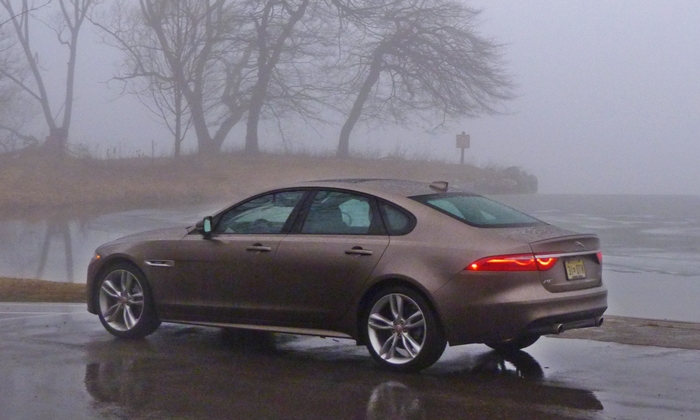
Elegant proportions. But not everyone notices this. Could the XF's styling be overly subtle?
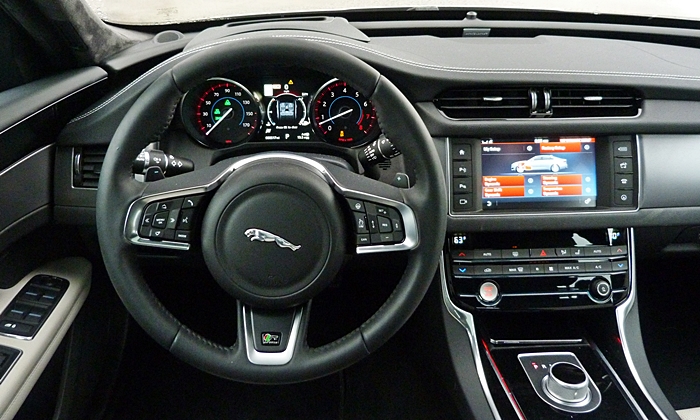
Some ergonomic flaws. Nice: set the mode separately for engine, transmission, steering, suspension.
| Handling |
 Better
Worse
Better
Worse
|
Classic Jaguars weren't renowned only for their styling. Lyons sought to endow his sedans with "grace, pace, and space." The new XF gracefully achieves pace. But competitors with six-cylinder engines are about as quick, and optional V8s make them even quicker (if, for nearly all drivers nearly all the time, needlessly so). So powertrain performance isn't a "why to buy" and will be covered later.
In addition to how the new XF looks and accelerates, "grace" also befits how it handles. In contrast to sport-suspended German competitors, the new XF doesn't seek to dominate the road by pounding it (and the driver) into submission. Instead, the XF gracefully works with the twists and turns, maintaining its composure even across pock-marked pavement. The XF feels lighter and more agile than the German cars, partly because it is about 300 pounds lighter, but also because of how it's tuned.
The XF's electrically-assisted steering responds and communicates better than most, but never feels heavy the way the German systems can. In the past, sporty steering meant heavy steering. But heavy steering makes a car feel heavier and less responsive. If, as is often the case, the reduction in assist delivers no benefits in communication, there's no point.
To be clear, the XF doesn't isolate occupants from the road. It's no cocoon. More than the Germans tend to these days, it communicates what's going on at the tire's contact patches. But even the optional 20-inch wheels, though they must be heavy, somehow don't communicate their heaviness the way 19s and 20s on German sedans tend to. Initial impacts can feel a touch firm, but never harsh.
The tested XF R-Sport had adaptive dampers. In the great majority of my driving these reacted quickly enough in normal mode that setting them to dynamic only served to make the ride more jiggly. "Dynamic" might have helped on the curviest roads, but the difference was small enough that it might have been in my head. The same goes for setting the steering to dynamic. I initially detected a modest firming-up on-center, but afterwards felt no clear difference. Especially in Audis the difference between steering modes can be much more dramatic.
The tested XF was not optioned with all-wheel drive. But it was fitted with winter tires. Good thing, as it snowed. Normally, I prefer not to test powerful rear-wheel-drive cars on snowy roads. But in this case I learned that, with winter tires and a talented stability control system, the rear-drive Jaguar handles snow just dandy. Not a single iffy moment. Only the steepest unplowed driveway in my neighborhood exceeded the car's capabilities. Get all-wheel drive if you'll be driving up steep snowy hills; otherwise it's not necessary. The flip side of this stability control system: in its default mode it won't let the XF oversteer even when you want it to. To really enjoy a curvy road, tap a button to dial the system back a notch.
I have made allowances for the winter tires. In rapid high-speed transitions the XF's rear end lost its normal discipline and took an SUV-like moment to settle. I suspect the car's suspension tuning was out of sync with the winter tires' soft, squishy tread blocks.
Overall, the XF isn't the sportiest-handling car in the class. That honor goes to the Cadillac CTS. But the Jaguar handles very well, and in its own, friendlier, often more enjoyable way.
| Rear seat room & comfort |
 Better
Worse
Better
Worse
|
And space? The real magic: the new Jaguar XF combines a sleek, sporty body with a usefully roomy and comfortable rear seat. There's more rear knee room than in the BMW 5-Series, and even than in the larger regular wheelbase Jaguar XJ. (For buyers who need even more legroom, Jaguar also offers an extended wheelbase version of the XJ.) If you compare the XF to German cars with at least equally sporty styling, it has a much roomier rear seat. The BMW 6-Series Gran Coupe, though a couple inches longer than the XF, has a cramped, uncomfortably positioned rear seat. The Mercedes CLS does better in its second-generation form, but still doesn't compare to the new XF in this regard. The Cadillac CTS, though its profile is very much that of a sedan, also has a tighter rear seat than the XF. For a combination of coupe-like styling, agile handling, and rear seat room, the new XF can't be beat.
But wait, there's more. Even though it retains a spare tire (BMW and Cadillac have tossed theirs), the new XF also has the roomiest trunk in the class--over 19 cubic feet. But the XF isn't offered as a hatchback or wagon. The Audi A7 hatchback remains the versatility champ among sporty midsize luxury cars.
The other thing keeping the XF from being the utility champ of its class: the center console storage area is barely there.
| Warranty, maintenance cost |
 Better
Worse
Better
Worse
|
Concerning any lingering reliability concerns: Jaguar hears them. Starting with the 2016s all Jaguars include a five-year / 60,000-mile warranty, a year and 10,000 miles more than competitors, plus five years and 60,000 miles of free maintenance.
| |
Compared to the 5-Series |
| Materials & workmanship |
 Better
Worse
Better
Worse
|
My initial sense was that the Jaguar XF's price ($73,485 as tested) rated a "why not to buy" slot. But, as we'll see, its price is in line with those for the BMW 535i and the Mercedes-Benz E400.
So, a slightly different issue: while the XF's interior certainly doesn't seem cheap, it also doesn't seem as lavishly outfitted as those in the Audi A6 and BMW 5 Series, much less that in the upcoming redesigned Mercedes-Benz E-Class. It doesn't help that the buttons feel clickier than those in expensive cars tend to, and that the doors close much like those on a good $30,000 car rather than like that of the archetypal bank vault. On the other side of the ledger, unlike those in the Audi and BMW the top of the XF's instrument panel is upholstered.
This shortcoming might be more one of design. The XF's interior styling lacks the artfulness of its exterior. There's nothing ugly, but also no feast for the eyes. Jaguar knows how to do beautiful interiors. Perhaps they feared cannibalizing sales from the XJ if the XF's interior were nearly as special. As is, it's perfectly acceptable for a $50,000 car, but marginal for a $70,000 car.
| Quietness |
 Better
Worse
Better
Worse
|
Similarly, the new Jaguar XF doesn't seem as quiet inside as many competitors do. This could be more a matter of the quality rather than the quantity of sound that penetrates the interior. It's not loud inside, just not tomb-like, either. The noise you do hear doesn't have the muffled quality that makes a car seem especially quiet. As a result, the XF isn't the sort of luxury car that feels like its traveling two-thirds as fast as it actually is.
Beyond a modicum of wind and road noise, when working the engine you hear the mechanical bits doing their thing (if less than in some other Jaguars and Land Rovers with this engine) and a throaty exhaust. These sounds might be music to the ears of driving enthusiasts, and they are part of recent Jaguars' distinctive personality, but many luxury sedan buyers want to hear as little as possible.
This said, people expecting a four-door F-Type might find the XF's engine and exhaust overly muted. No one's ears will be especially happy--unless they're listening to the audio system, which even in standard 380-watt form is quite good.
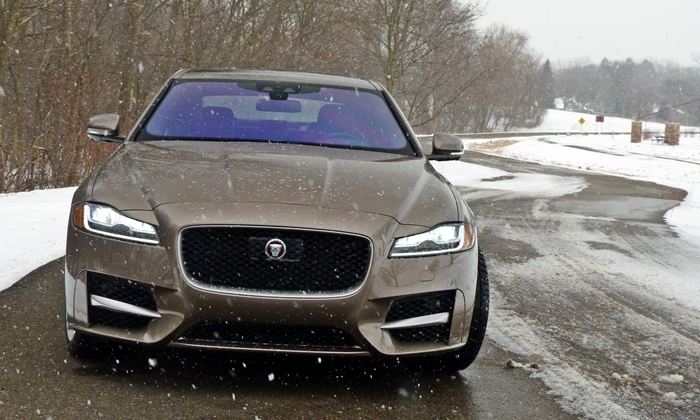
A powerful rear-drive car on snow and ice? Not a problem with winter tires. And no oversized grille.
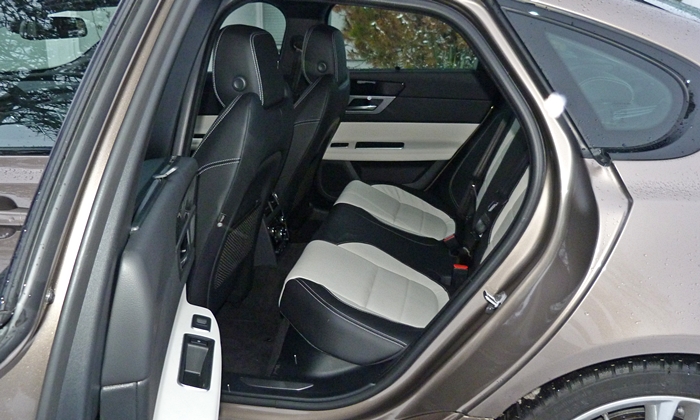
Roomy rear seat, despite what the XF's sleek styling might suggest.
| Front seat support & comfort |
 Better
Worse
Better
Worse
|
Continuing my interior nitpicking, I'll add that the new Jaguar XF's seats provide acceptable support and comfort, but the seats in some competitors are exceptional. Jaguar lags here. It might help to step up to the 380-horsepower XF S (which actually costs a little less than the tested 340-horsepower R-Sport), as its seats include power adjustments for the side bolsters and cushion length.
The rear seat, though usefully roomy, is also on the firm side.
On a positive note, the XF's driving position is very good. The instrument panel isn't overly large or imposing, and the windows are reasonably large and are not too steeply raked. Outward visibility is at least as good as that in the BMW 5 Series and much better than in the scrunched down 6 Series Grand Coupe.
| Controls and instruments |
 Better
Worse
Better
Worse
|
Jaguar has improved the layout and operation of the controls in the new XF, but not enough. The buttons for the rear windows are about where you expect those for the front windows to be. Those for the front windows are another inch away, and the mirror controls are nearly beyond reach without leaning forward (at which point you couldn't see the mirror while adjusting it). The display for the infotainment system is mounted too low to view without taking your eyes off the road. To adjust the seat heaters, you must find a button among a row of similar buttons on the center stack, tap it, then adjust the seat using virtual buttons on the display. The driving modes are adjusted using small buttons located too far back on the center console to view while driving, and feeling around for them isn't ideal. BMW mounts larger drive mode buttons much farther forward. Audi and Mercedes also make them easier to find and operate.
An option package will soon be available that includes reconfigurable LCD instrumentation, a more powerful audio system, and an upgraded navigation system with a larger, ten-inch display (the physical buttons to each side of the standard eight-inch display become virtual buttons). One downside, a big one for me: the throttle, transmission programming, steering, and suspension will not be independently configurable with the last. As a result, with this package if you want tight steering, you'll also get a more jiggly ride and fuel-wasting powertrain behavior.
| |
Compared to the 5-Series |
| Powertrain performance |
 Better
Worse
Better
Worse
|
As mentioned when discussing the XF's handling, it's a very quick car, but so are competitors.
With a 340-horsepower supercharged 3.0-liter V6 driving the rear or all four wheels through an eight-speed automatic transmission, and about 110 pounds less weight to motivate than in the original thanks to the all-aluminum body, the new Jaguar XF can get from a dead stop to 60 mph in about five seconds. (You can get another 40 horsepower in the top-of-the-current-range XF S, but according to Jaguar the additional ponies shave only a tenth of a second.) The engine feels strong throughout its range, really comes alive around 4,000 rpm, and never seems strained. To sharpen its responses to lightning-quick, switch to dynamic mode using a button on the center console or twist the transmission's shifter-dial to S. Even without the torque-distributing benefits of the optional all-wheel-drive system the chassis easily manages the engine's output.
This said, competitors have their own about equally strong boosted sixes, plus boosted V8s for the increasingly small percentage of buyers who deem the sixes insufficiently quick. Supercharged V8s were offered in the previous XF, and will likely find their way into the new one, but never during my week with the car did I feel the need for more power.
| Fuel economy |
 Better
Worse
Better
Worse
|
A decade ago a midsize sedan capable of both a five-second run from zero to 60 and EPA ratings of 20 mpg city / 30 mpg highway (improved significantly from the 2015's 17/28) would have been astounding. Today, though, it's just par for the course. Plus competitors are available with four-cylinder engines that are evern more efficient. The XF will be available with both gas and diesel four-cylinder engines in the future.
In my real-world driving I observed averages as high as 25 mpg in the suburbs once the engine was warm, but more often high teens and low 20s, depending on how aggressively I was working the pedals. The average for the entire week was just 18, but this included cold starts, time spent idling while taking a couple hundred photos (this was a very fun car to photograph), and a stint in the single digits exploring the XF's handling potential.
Note: the relative rating is actually against the 535i. The 535d, with a powerful yet efficient diesel engine, is the "compared to" car since it is the 5 Series I most recently reviewed.
| Price or payments |
 Better
Worse
Better
Worse
|
Finally, about the new Jaguar XF's price: it can seem high, about right, and maybe even low depending on how you look at it.
Jaguar isn't counting entirely on the redesigned XF, the new XE compact sedan, the new F-Pace crossover, a longer warranty, and free maintenance to boost sales. It has also made its cars more affordable. Sort of. Compared to the least expensive 2015 XF with the 340-horsepower supercharged 3.0-liter V6, the least expensive 2016 XF with the same engine lists for over $5,000 less, a mere $52,895. But this is entirely because last year's car had nearly $6,000 in additional features. To get less content with the 2015 you also had to get the 240-horsepower turbocharged 2.0-liter four-cylinder engine. Configure both cars similarly and the 2016 costs about $5,000 more. So much for "more affordable." In the 2016's defense, it is a much better car than the 2015.
Compared to other cars in the Jaguar range, the XF is about $11,000 more than the upcoming XE but about $8,000 less than the XJ. Don't need much of a rear seat? Want more agile handling? Save big with the XE. Want a stylish interior? Spend the extra for the XJ.
The tested XF, a nearly fully loaded rear-wheel-drive R-Sport, had a bottom line over $20,000 north of the model's starting price, $73,485. All-wheel drive would add another $3,000, and a Technology package with reconfigurable LCD instrumentation, an upgraded navigation system, and 825 watts of surround-sound audio would add another $3,100 (but isn't available yet). Add these, and the sticker of the XF would get awfully close to $80,000.
The odd thing is, if you add just the adaptive dampers and 20-inch wheels to the R-Sport, it costs $450 more than the XF S, which has these features, more adjustable front seats, and a 380-horsepower variant of the same engine as standard equipment. Granted, Jaguar claims acceleration is somehow virtually the same with the more powerful engine, but 380 horsepower sounds quite a bit more exciting than 340. And Jaguar charges over $10,000 for the same engine upgrade in the F-Type sports car. So the R-Sport really makes no sense.
Compared to other premium midsize sedans, the Jaguar XF is about $11,000 more than a Lexus GS 350 F Sport, over $4,000 more than the Cadillac CTS, nearly $4,000 more than the Audi A6 (both equipped with AWD), about the same as the BMW 5 Series, and about $3,000 less than a Mercedes-Benz E400. It's within the range, but towards the high end. Compared to the coupe-like variants of these cars, though, the XF costs much less. Specifically, it costs about $8,000 less than a Mercedes-Benz CLS400 and over $13,000 less than a BMW 640i Gran Coupe. These four-door coupes do have much nicer interiors than the XF does, though. Overall the XF seems somewhat reasonably but not aggressively priced.
With the XF, and likely the upcoming XE and F-Pace as well, Jaguar reminds me of another brand whose cars I tend to love, Mazda. Both companies are relatively small and depend on doing things differently to survive. Compared to other premium luxury sedans, the XF isn't as insulating, as cushy, or as lavishly furnished. But it's not far off the mark in these areas, either. Then in styling, handling, and driver involvement the new XF is at the head of its class, without significantly compromising practicality or livability. Not an easy combination to pull off.
Unlike with Mazda, reliability remains a concern. To counter this, Jaguar now includes a five-year, 60,000-mile warranty plus free maintenance.
If your priorities align with the XF's strengths and weaknesses like mine do, and you're shopping for a car in this class, then it's time to visit a Jaguar dealer. Are there enough such people to reduce the huge sales gap between the class leaders and the XF? I'd like to think so. We shall see.
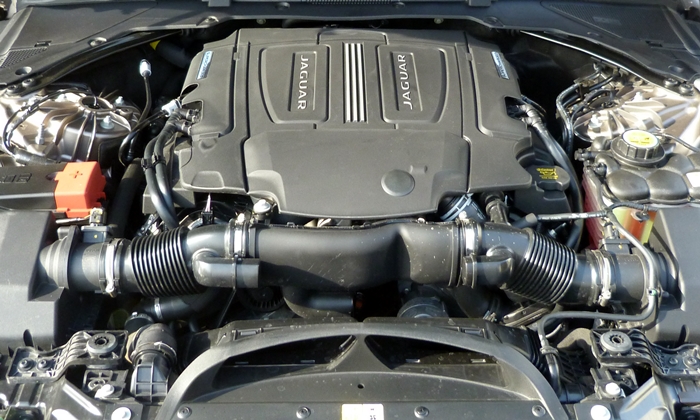
The supercharged V6 is powerful and fairly efficient, but could be more refined.
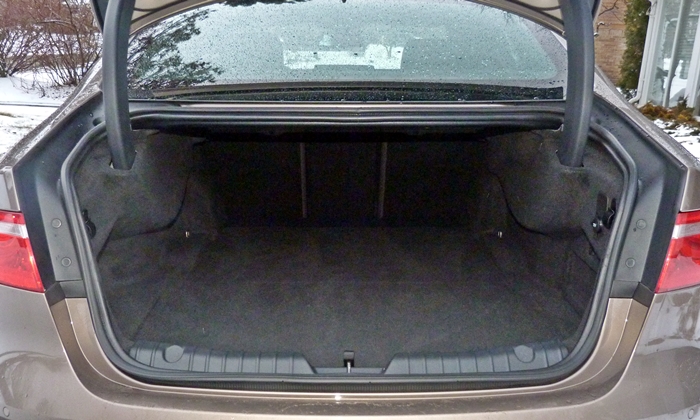
Roomiest trunk in the class, even with a spare tire beneath its floor.
See more 2016 Jaguar XF photos
Jaguar and BMW provided insured cars for a week with a tank of gas.











